In My Orange Phase.




In my orange phase.
More Posts from Exobiotica and Others





The Challenger
A new competitor has entered the misty valley. Attracted by ample food supply, the hopeful newcomer will have to contend with the reigning resident of this territory. In times of scarcity, populations begrudgingly coexist in shrinking pockets of such favorable habitat, but rain and sun have been plentiful lately, so a battle seems imminent.

Veteris-42820 C
Finally a planet to house (most of) the creatures I've designed so far. A terrestrial planet with about 2/3 the mass of Earth, it orbits its K-type star, Veteris, within the habitable zone. This system is around 8 billion years old - about twice that of ours, hence the name Veteris, which is Latin for "old". It sits at the outskirts of the nebula behind it, which will still be busy birthing star systems for billions of years to come. Veteris is a good analog for earth- it has a similar chemical composition (including its atmosphere, which is slightly more dense - at about 1.5 atm) so it's a good place to begin our journey.






First Light
Dawn breaks in the desert, revealing a scurrying frenzy of creatures returning to shelter after the night’s mischief. Tallest among them, the Cycloptic Night-Seeker surveys the scene looking for any last morsel of food before the day’s solar onslaught forces its retreat into shadow. The Testapallidus at its feet may prove an ideal treat, unless the sand-swimming Armored Loricatus captures it first. Though the Testapallidus’ hard dorsal shell protects it from most threats, the Night-Seeker possesses a keen intellect, curious disposition, and two formidable front appendages that are as dextrous as they are sharp. Usually too quick for the large hunter, a trio of gregarious Desert Sentinels are more concerned with ambush predators such as the Loricatus, and one inflates its signaling air sacs in alarm. Already, members of the desert’s daytime cast are making an appearance. Luteos have positioned themselves at the top of the ridge to greet the first slanted rays. Relying on photosynthesis for a large portion of their metabolism, they tilt their bodies to follow the sun throughout the day. In a short time, more heat-tolerant daylight denizens will take the stage and play out their part in the everyday drama of the high desert.
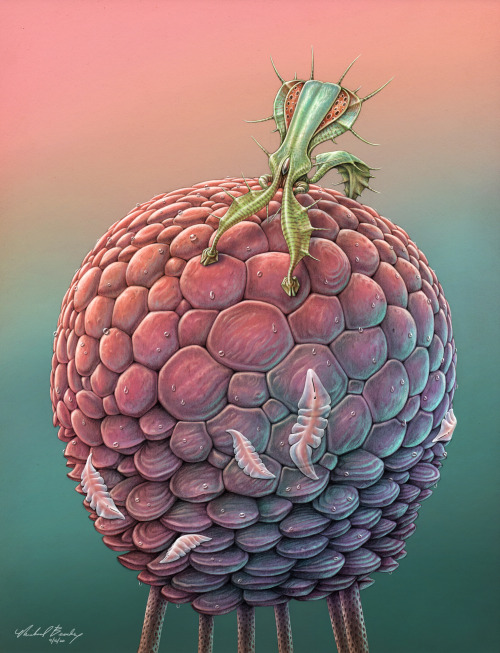
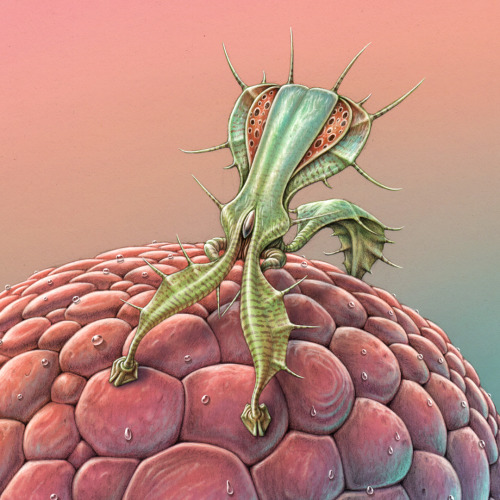
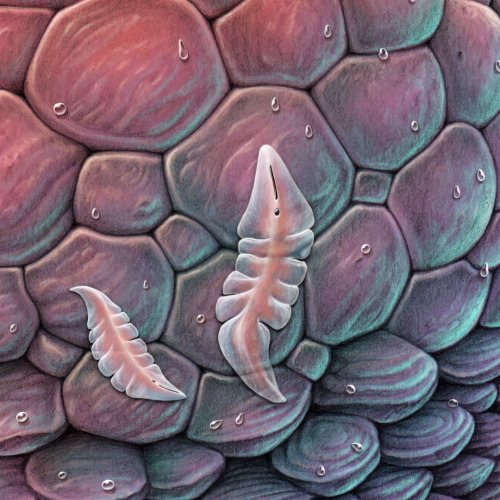
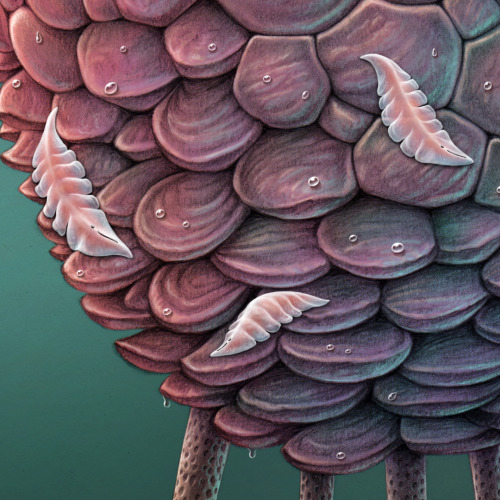
Guardian
On Veteris, it is common for creatures to obtain energy from multiple sources. The large round, multifaceted autotroph angles its plates to face the light at any given time of day. It also feeds on decomposing organic matter it obtains by moving slowly on its long spindly legs. Conversely, the spiny guardian on top originally evolved to hunt the semi-transparent flat creatures that feed on the autotroph, but came to rely on them exclusively. Over many generations, individuals that allowed some prey items to live and reproduce eventually outlasted the more aggressive hunters, and now their style of subsistence is closer to farming. The guardians now protect the entire micro-system – each large round walker and its flock of parasites is topped by a spiny guardian who has the dual task of defending against predators as well as keeping the herd numbers in check. A round walker without a guardian slowly succumbs to parasite overpopulation. Occasionally huge numbers of walkers congregate in vast gently-swaying miniature forests, each crowned by a flamboyant spiny guardian defending its small world.

Grandulus
Trifasciatus grandulus
I should preface the description of this creature by giving a short statement about the natural history of its home planet. Early in its evolutionary history, life on this world did not split into such rigidly defined taxa as it did on Earth. For example, the majority of multicellular earth-life is divided into autotrophic creatures (plants) which are immobile, and the highly mobile heterotrophs (animals). On grandulus’s planet, the peculiar biochemistry allows for a much higher rate of horizontal gene transfer and endocytosis. This means that instead of a taxonomic “tree of life” like on Earth, their evolutionary history looks more like a web. In short, this allows for a wide array of photosynthetic, yet mobile creatures. The grandulus is one of these. It moves around slowly with its sticky appendages and positions itself in a spot with maximum sunlight to unfold its inflatable photosynthetic organ from its posterior shell. It also feeds on the internal fluids of metaflora, as well as decaying organic matter. Its many species range in size from that of a quarter to the size of a hippo.






Monolith
The seasonal rains have come to the high desert. Among the first to respond is the monolith. It sends out hose-like tendrils to siphon water and turns on its biolights to attract flying symbionts.
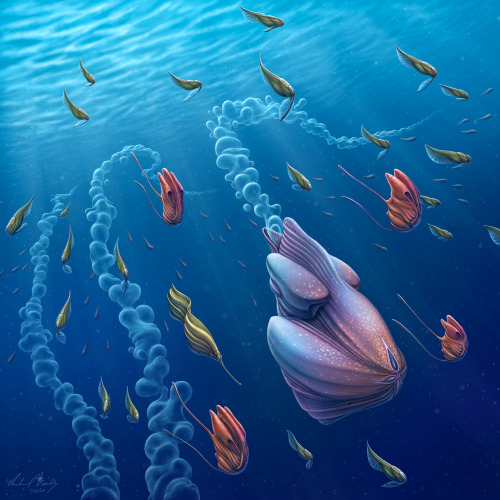
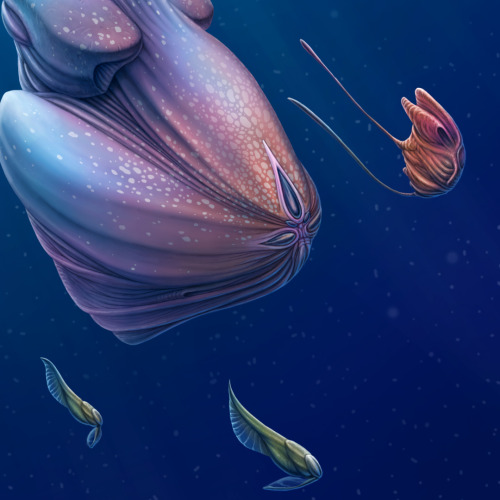
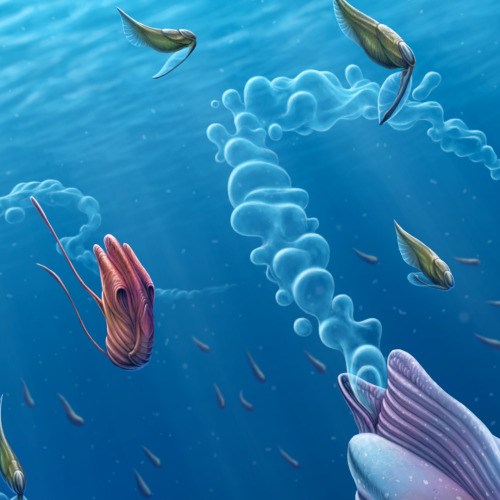
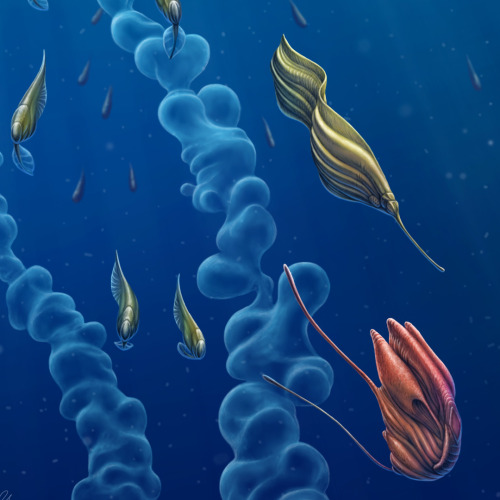
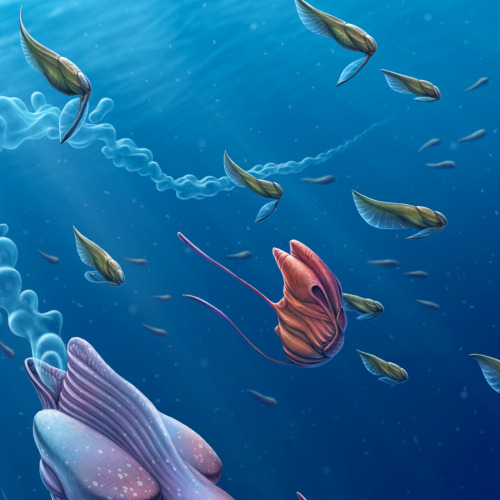
Back to the Depths
An entourage of opportunistic creatures accompanies the deep-sea behemoths during their brief ascent to the surface. Releasing their gelatinous strings of embryos here in the sunlight has a significant benefit - there's far more visibility. The swarm of followers are here in search of a quick meal in the form of the gelatin, which is full of valuable protiens and nutrients. After the feast however, the recipients of this apparent windfall become unwitting hosts for the behemoth's multitudinous offspring, which were embedded in the gel. Adapted to develop inside a wide variety of pelagic creatures, the young grow internally - and sometimes even on the surface of - their hosts until such time as they detach and sink back into the darkness. For most host species, this seems to be a mutually-beneficial symbiosis. At the beginning they receive a large and valuable meal, and usually incur very little detriment due to their temporary parasites. The young behemoths will hide in the dark depths for many years until attaining the size necessary to return to the light and repeat the ancient cycle again.



Curiosity
A massive predator on the ocean floor lures in its next naive dinner guest. The smaller creatures that surround it have been waiting for this moment.





Forest Floor
The long tendrils of the Purple Spire Creeper encircle this forest community deep in the valley. Following its traditional hunting path by the river, the predatory Veloxos has spotted its prey – a Dish-Faced Septaped that emerged from the undergrowth for a drink. The Septaped’s teal, reflective surface camouflages it well in its dimly-lit damp home on the forest floor, but now out in the open it appears as a shining beacon. After this brief instant of mutual acknowledgment, the race begins. The Veloxos’ three powerful hydraulic legs can propel it with surprising swiftness to get it within striking range of its harpoon-like proboscis, which extends almost instantaneously to the full length of its body. The Septaped is a formidable quarry. Though it possesses no defensive mechanisms, the seven muscular legs aligning its body can nearly teleport it back to its shady lair - where it will become lost in the shadows. The perpetual arms-race of natural selection continues daily all across the planet with countless moments such as this.




Kings of the High Desert
A herd of strange creatures has congregated on this rocky outcrop. Known as Emperor Shinebacks, they often climb these rugged foothills to obtain access to cooling breezes and additional food sources. Their top-heavy tripodal stature prevents further ascension into the mountains, but it serves them well on more level ground. Reflective carapaces mitigate much of the sun’s harmful rays, and cooling flaps along their flanks dissipate excess heat. A shineback’s normal gait is rather clumsy, but when haste is needed they clamp all three legs together into a single monopod and bounce effortlessly across the desert at remarkably high speeds. This combined with their massive size (adults are over eight feet tall) and protective social behavior makes them almost impervious to attack. Almost…
-
 dollygarden liked this · 1 week ago
dollygarden liked this · 1 week ago -
 delta-trox liked this · 3 weeks ago
delta-trox liked this · 3 weeks ago -
 fallingintowrongterritories liked this · 2 months ago
fallingintowrongterritories liked this · 2 months ago -
 deathofdelta liked this · 2 months ago
deathofdelta liked this · 2 months ago -
 big-bee-png liked this · 2 months ago
big-bee-png liked this · 2 months ago -
 tgrzrk reblogged this · 2 months ago
tgrzrk reblogged this · 2 months ago -
 tgrzrk liked this · 2 months ago
tgrzrk liked this · 2 months ago -
 critterbugboi liked this · 2 months ago
critterbugboi liked this · 2 months ago -
 cricketbombed liked this · 3 months ago
cricketbombed liked this · 3 months ago -
 pokepoke18 liked this · 3 months ago
pokepoke18 liked this · 3 months ago -
 ceo-of-sloppy-women liked this · 4 months ago
ceo-of-sloppy-women liked this · 4 months ago -
 tiktokrizzparty liked this · 4 months ago
tiktokrizzparty liked this · 4 months ago -
 wrstudio-br liked this · 4 months ago
wrstudio-br liked this · 4 months ago -
 fattcatt1123 liked this · 4 months ago
fattcatt1123 liked this · 4 months ago -
 mrbgs101 liked this · 4 months ago
mrbgs101 liked this · 4 months ago -
 godzillafandoesart liked this · 5 months ago
godzillafandoesart liked this · 5 months ago -
 saltylittlecreature reblogged this · 5 months ago
saltylittlecreature reblogged this · 5 months ago -
 mcpieandhaggis reblogged this · 5 months ago
mcpieandhaggis reblogged this · 5 months ago -
 potatosapien5 liked this · 5 months ago
potatosapien5 liked this · 5 months ago -
 woeful-salt-eater liked this · 5 months ago
woeful-salt-eater liked this · 5 months ago -
 small-amethyst liked this · 5 months ago
small-amethyst liked this · 5 months ago -
 carpinthemdiems liked this · 6 months ago
carpinthemdiems liked this · 6 months ago -
 summerlimeismethebrony liked this · 6 months ago
summerlimeismethebrony liked this · 6 months ago -
 im-here-just-to-read liked this · 6 months ago
im-here-just-to-read liked this · 6 months ago -
 paidelosmontes liked this · 6 months ago
paidelosmontes liked this · 6 months ago -
 lampthegloomyone liked this · 6 months ago
lampthegloomyone liked this · 6 months ago -
 planariaareneat liked this · 6 months ago
planariaareneat liked this · 6 months ago -
 planariaareneat reblogged this · 6 months ago
planariaareneat reblogged this · 6 months ago -
 femursforyou liked this · 6 months ago
femursforyou liked this · 6 months ago -
 themslash reblogged this · 6 months ago
themslash reblogged this · 6 months ago -
 basementnaw liked this · 6 months ago
basementnaw liked this · 6 months ago -
 anauthorwhoknowsnothing reblogged this · 6 months ago
anauthorwhoknowsnothing reblogged this · 6 months ago -
 anauthorwhoknowsnothing liked this · 6 months ago
anauthorwhoknowsnothing liked this · 6 months ago -
 deathlyborb reblogged this · 6 months ago
deathlyborb reblogged this · 6 months ago -
 deathlyborb liked this · 6 months ago
deathlyborb liked this · 6 months ago -
 balaklaus13 liked this · 6 months ago
balaklaus13 liked this · 6 months ago -
 vesperthealchemist liked this · 6 months ago
vesperthealchemist liked this · 6 months ago -
 durzio liked this · 6 months ago
durzio liked this · 6 months ago -
 philipkampp reblogged this · 6 months ago
philipkampp reblogged this · 6 months ago -
 squidpantsyoho liked this · 6 months ago
squidpantsyoho liked this · 6 months ago -
 legged-anomalocaris liked this · 6 months ago
legged-anomalocaris liked this · 6 months ago -
 bellabfield liked this · 6 months ago
bellabfield liked this · 6 months ago -
 roguenightpanda reblogged this · 6 months ago
roguenightpanda reblogged this · 6 months ago -
 roguenightpanda liked this · 6 months ago
roguenightpanda liked this · 6 months ago -
 followingthefanfiction reblogged this · 6 months ago
followingthefanfiction reblogged this · 6 months ago -
 followingthefanfiction liked this · 6 months ago
followingthefanfiction liked this · 6 months ago -
 freshrranchfirefestival liked this · 7 months ago
freshrranchfirefestival liked this · 7 months ago